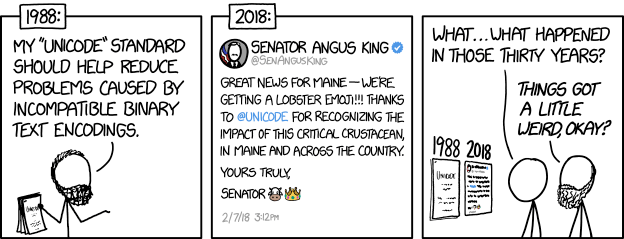Emojis and the Web
Slowly but surely, emojis spread from the mobile phone text messages through social media sites, clickbait articles and forums into the vastness of space (or the internet, whatever). Using emojis in texts, web pages and titles is getting more and more common recently.
One thing is for certain, they’re here to stay for now 👋.
Emoji Domains
One specific use case that has seen a surprising amount of media attention in the past years, was the topic of emoji domains. This has generally been made possible by the implementation of Internationalized Domain Names (IDN), through which the use of unicode symbols in domain names was made possible. Originally, IDNs were created to enable website names with URLs that can’t be expressed using the regular ASCII charset. One such example is for instance Munich’s internationalized domain version: www.münchen.de.
These domains don’t really exist as far as the DNS-System is concerned, but already get converted into another form in the Web Browser. This conversion from unicode into the ASCII space is known as punicode1 and is defined as a part of the IDN standard. So what actually happens to Munich’s domain from above, is that it get’s converted to www.xn--mnchen-3ya.de, which can be opened like any regular URL. The same process is also applied for emoji domains: the emoji string 🍳🍳🍳 gets converted into xn--qj8haa. This conversion, however, is not supported on any domains and on any browsers: The previously outlined .de top level domain (as well as .at2 and .ch) only supports unicode characters used in the german language.
If you just want to see the conversion result of some Emoji to punicode domains, you can use the conversion tool at punycoder.com.
Luckily, there are some other top level domains that do not propose such strict restrictions. According to i❤.ws, these currently are .cf, .ga, .gq, .la, .ml, .tk, .st, .fm, .to, .je, .gg, .kz and .ws. The first domains accessible via emojis were reserved in 2001, even though browsers didn’t yet allow access to them back then. The first also accessible emoji domain however was http://💩.la/3.
The Dark Side of Unicode Domain Names
Until very recently, emoji (and generally unicode domains) had the drawback of being ranked lower in search engine results. This generally often happens for domains of smaller countries, but recently was adressed by relevant search engine operators.
Furthermore, even though emoji domains are generally more easy to remember and recognize (and are therefore often used for marketing purposes - see Coca Cola’s 😀.ws marketing stunt 4).
Unicode domains have also attracted criticism for their widespread use in combination with hoaxes. In the german speaking world for instance, there was widespread chain-message advertising a free gift basket of chocolate for signing up on the milka.com website with name and address5. The phishers actually didn’t send links to milka.com but rather mılka.com using a unicode domain that includes a character similar to an i without the dot6 in the URL.
Even though emojis domains are nowadays supported in all modern browsers - no matter if on desktop or mobile - E-Mail clients still have their fare share of problems rigth now. In practice, that means that for sending E-mails to unicode domains, you often just have to send the E-Mail to the punicode encoded domain. This can, however, be confusing to a user that now uses seemingly different domains for visiting a site and sending emails to it’s admins, employees or users.
Who even uses that?
| Site | Emoji URL | Encoded URL |
|---|---|---|
| AngelList | ✌️.com | xn–7bi.com |
| Mailchimp | 💌.ws | xn–rr8h.ws |
| Budweiser | 🍺🍺🍺.ws | xn–xj8haa.ws |
| MGM Grand resort | 🃏.ws | xn–fz7h.ws |
- Emojis are increasingly used in website content (be it titles, headers or regular content) that is expected to be viewed on mobile devices - which is more or less every site published nowadays.
-
More and more blogs and sites use unicode symbols or emojis as simple favicons, and most browsers also support this without problems. This also has the benefit of basically being able to include a favicon within a simple inline svg, as also outlined by Lea Verou7 in a Twitter post.
<link rel="icon" href="data:image/svg+xml,<svg xmlns=%22http://www.w3.org/2000/svg%22 viewBox=%220 0 100 100%22><text y=%22.9em%22 font-size=%2290%22>🥬</text></svg>">
Why this is all a bad idea
As the following image and the paper it’s from illustrate, there can be very big differences in the ways emojis are displayed depending on the viewers platform that can lead to misunderstandings.

photo credit: Bai, et. al (2019) - A Systematic Review of Emoji: Current Research and Future Perspectives, emojipedia.org
Arguably, using emojis in messages and texts can make communication faster, but sometimes also more complicated to understand. Tigwell, et. al8 argue that getting your point across using emojis depends on a shared understanding of the emoji’s underlying emotion, that is of course not necessarily present. They propose a system that basically translates emojis from the sender’s emotional spectrum into the receiver’s emotional spectrum. While this can work in helping the receiver understand what’s being sent to him, it certainly does not make communication easier.
On a similar note, I have to end this blog with a reference to a relevant XKCD comic, that is also questioning if the Unicode standard is still true to its original mission.

photo credit: Randall Munroe, via xkcd.com
bonus content: Alivia created an emoji Sudoku for everyone who hates numbers but still wants to do Sudokus. You can check it out on her blog here.